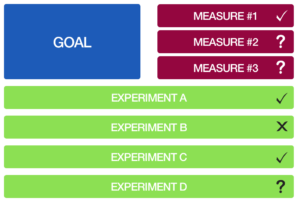GEMs
An alternative to OKRs (Objective Key Results) for those that think in experiments
Chris Baynham Hughes
What Is GEMs?
Created by Kathy Keating, GEMs (Goal Experiments Measures) provide an approach to objective setting and measurement.
It is an alternative to OKRs (Objective Key Results) and SMART (Specific Measurable Achievable Relevant Time bound) goals.
Why Do GEMs?
The thorny world of objective setting can kill a team's drive. Different people gravitate towards different models, but it is generally agreed that top down, cascaded objectives deserve to rot in the 90's. As teams move towards greater autonomy, translating the purpose and vision into meaningful and measurable activities can be uncomfortable at best. Enter GEMs - Goal : Experiments : Measures.
Many of the practices within the Open Practice Library encourage the adoption of a 'culture of experimentation'; GEMs fit perfectly with that mindset. It's a common objection that OKRs lack the path to get from the objective to the key result We've all struggled to write SMART objectives in the past; felt stupid and then put them in the draw until review time, but GEMs help to address these difficulties and the discomfort by making explicit the experiments we wish to undertake to achieve the objectives.
Best of all, if outside of your team (or even within it) OKRs or SMART objectives are being used, it's easy to take GEMs and re-phrase into either OKRs or SMART objectives. This means you don't need to fight the system in place if it's not GEMs and you find GEMs sit better with you.
If your organisation is using the OKR framework:
- The Goal (G) is your Objective (O)
- The Measures (M) are your Key Results (KR)
If your organisation uses the SMART goals framework, simply combine your Goal and your Measures into a single statement; e.g.,
- Increase the number of active users on our platform
by creating an easy to use referral scheme that results in an average of one referred customers per current user every quarter
and by delivering an NPS greater than 25 within 60 days of onboarding
GEMs evolve at the speed of the experiments and provide a way of holding teams to account whilst accepting that we cannot predict the future. As the situation changes, so can the experiments, there is no need to wait until a specific time boundary or continue on a path you know is wrong as your understanding evolves. This engenders greater psychological safety within the team and an acceptance that we value moving towards the target over a 'hit or miss' mindset.
How to do GEMs?
-
Set a goal - this must be relevant and achievable for both individuals and teams to influence.
The goal should be something that it is understood; why you are looking to achieve it. Dream big, envisage the future state, what do you want to see, hear, feel, do?
NOTE: These do not need measures at this stage.
Examples:
- Increase the number of active users per month
- Increase revenue per customer
- Improve the quality of the time spent with my children
- Exercise more to improve fitness and mental health
-
Think of the experiments you could run in order to get closer to the goal. Other practices within the library can help here; e.g., 10-for-10 and Impact Mapping are both great for this.
Example:
- Goal: Increase the number of active users per month.
- Possible experiments: Set up a referral scheme, run an advertising campaign, cut down the effort for registration, provide points for usage or cash back incentives, run user research to understand barriers to usage
-
Sort your ideas based upon impact and effort this practice can help. How confident are you that you will be able to deliver the experiment? If you are setting these objectives as a team, discuss this and maybe use a confidence voting like Fist to five or even dissent cards to determine the best options. There is no right or wrong to this, it's really about prioritising the experiments you are going to run to move closer to the goal.
-
Ask the question, How are we going to measure this? How will we know our actions have been successful? Like any good experiment you need to understand what you're looking for as well as how and when you'll gather the data to make your assessment(s)
Example:
- Goal: Increase the number of active users per month.
- Experiments: Set up a referral scheme, run an advertising campaign, cut down the effort for registration, provide points for usage or cash back incentives, run user research to understand barriers to usage
- Measures: An average of two new referred users per quarter; Reduction in average sign up time by 30%; Increased usage by average 3 transactions per user per month following the introduction of reward points; 5 point improvement in NPS for existing (registered pre Aug 2021) customers within 3 weeks of introducing changes recommended by user research.
-
Keep score. Update the score card weekly or at the end of each sprint/ logical (but short) time period. The link to Kathy Keating's original blog post on GEMs provides a suggested template for tracking.
Look at GEMs
Links we love
Check out these great links which can help you dive a little deeper into running the GEMs practice with your team, customers or stakeholders.
